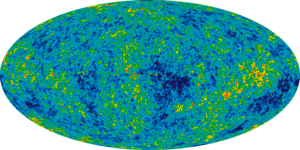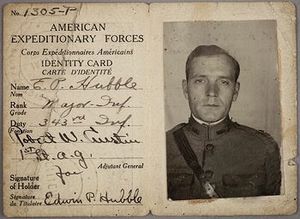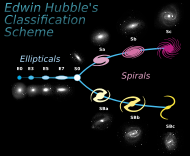Edwin Hubble facts for kids
Quick facts for kids
Edwin Hubble
|
|
|---|---|

Portrait by Johan Hagemeyer, 1931
|
|
| Born |
Edwin Powell Hubble
November 20, 1889 Marshfield, Missouri, U.S.
|
| Died | September 28, 1953 (aged 63) San Marino, California, U.S.
|
| Alma mater | |
| Known for |
|
| Spouse(s) |
Grace Burke Sr.
(m. 1924) |
| Awards |
|
| Scientific career | |
| Fields | Astronomy |
| Institutions | |
| Influenced | Allan Sandage |
| Military career | |
| Allegiance | United States |
| Branch | Army |
| Years of service | 1 |
| Rank | Major |
| Unit | 86th Division 343rd Infantry Regiment 2nd Battalion |
| Battles/wars | World War I |
| Signature | |
| Physical cosmology | ||||||||||||||
 |
||||||||||||||
| Universe · Big Bang Age of the universe Timeline of the Big Bang Ultimate fate of the universe
|
||||||||||||||
Edwin Powell Hubble (born November 20, 1889 – died September 28, 1953) was a famous American astronomer. He made huge discoveries that changed how we understand the Universe. He helped create the fields of extragalactic astronomy (studying things outside our galaxy) and observational cosmology (studying the universe by watching it).
Hubble proved that many objects once thought to be just clouds of dust and gas, called "nebulae," were actually entire galaxies far beyond our own Milky Way. He used a special relationship found by Henrietta Swan Leavitt. This relationship connects how bright a certain type of star (a Cepheid variable) is with how often it pulsates. This helped him figure out how far away these galaxies were.
He also found evidence that galaxies are moving away from Earth. The farther a galaxy is, the faster it moves away. This idea is now known as Hubble's law. It means that the universe is actually getting bigger, or expanding! An astronomer named Vesto Slipher had seen signs of this expansion earlier. He noticed that light from many nebulae was "red-shifted," meaning it was stretched out, like a siren's sound changing pitch as it moves away. This showed they were moving very fast.
Hubble's name is probably most famous because of the Hubble Space Telescope. This amazing telescope, which orbits Earth, was named in his honor. You can even see a model of it in his hometown of Marshfield, Missouri.
Contents
Early Life and Education
Edwin Hubble was born in Marshfield, Missouri. His parents were Virginia Lee Hubble and John Powell Hubble, who worked in insurance. In 1900, his family moved to Wheaton, Illinois.
When he was young, Edwin was known more for his athletic skills than his schoolwork, though he did get good grades. He was a talented athlete who played baseball, football, and ran track. In 1906, he won many awards in a single high school track meet. He also played basketball and helped the University of Chicago's basketball team win their first major title in 1907.
College Studies
At the University of Chicago, Hubble studied mathematics, astronomy, and philosophy. He earned his bachelor's degree in 1910. He also joined the Kappa Sigma Fraternity.
Hubble then received a special scholarship called a Rhodes Scholarship. This allowed him to study for three years at The Queen's College, Oxford in England. He studied jurisprudence (law) there, which was a promise he made to his father. He also studied literature and Spanish, eventually earning his master's degree.
In 1913, while Edwin was still in England, his father passed away. Edwin returned home to help care for his mother and younger siblings.
Becoming an Astronomer
Even though he studied law, Edwin was always very interested in astronomy. After his father died, he didn't feel like practicing law. Instead, he taught Spanish, physics, and mathematics at New Albany High School in New Albany, Indiana. He also coached the boys' basketball team there.
After a year of teaching, he decided to go back to school. With help from a former professor, he went to graduate school at the University of Chicago's Yerkes Observatory. There, he studied astronomy and earned his Ph.D. in 1917. His main project was called "Photographic Investigations of Faint Nebulae." At Yerkes, he could use one of the most powerful telescopes of that time, which had a 24-inch (61 cm) mirror.

When the United States entered World War I in 1917, Hubble quickly finished his Ph.D. so he could join the military. He volunteered for the United States Army and became a Major. He was ready for duty overseas, but his division never saw combat. After the war, Hubble spent a year at Cambridge University, where he continued his astronomy studies.
Career Highlights
In 1919, a famous astronomer named George Ellery Hale offered Hubble a job. It was at the Carnegie Institution for Science's Mount Wilson Observatory in California. Hubble worked at Mount Wilson until he passed away in 1953.
Just before he died, Hubble became the first astronomer to use the huge 200-inch (5.1 m) Hale Telescope at the Palomar Observatory in California. This was a very important moment in astronomy.
During World War II, Hubble also helped the United States Army. He worked at the Aberdeen Proving Ground in Maryland. He was the Chief of the External Ballistics Branch, where he led research on how bombs and projectiles fly. He even invented new equipment, like a high-speed camera, to study these things. His work greatly improved the design and power of bombs and rockets. For his service, he received the Legion of Merit award.
Major Discoveries
Is the Universe Bigger Than the Milky Way?

When Edwin Hubble arrived at Mount Wilson Observatory in 1919, the 100-inch (2.5 m) Hooker Telescope was almost finished. It was the biggest telescope in the world at the time. Back then, most scientists believed that the entire universe was just our own Milky Way Galaxy.
Using the Hooker Telescope, Hubble found special stars called Cepheid variables. These stars are like "standard candles" because their brightness tells you how far away they are. He found these stars in several "nebulae," including the Andromeda Nebula and Triangulum Nebula.
Hubble's observations in 1924 proved something amazing. These nebulae were much too far away to be inside the Milky Way. They were actually entire galaxies, separate from our own! This discovery completely changed how scientists saw the universe. These objects are now called galaxies, not nebulae.
This idea had been suggested before, as early as 1755, but many astronomers didn't believe it. One famous astronomer, Harlow Shapley, strongly disagreed. But Hubble, who was 35 at the time, published his findings. First, The New York Times reported it in November 1924. Then, he presented his findings to other astronomers in January 1925. His full scientific paper was published in 1929.
Hubble's discoveries completely changed the scientific view of the universe. Even though some famous scientists doubted him, Hubble's work helped future astronomers. His published work earned him an award called the American Association Prize.
Hubble also created a system to classify galaxies based on how they look in pictures. He organized them into what is now known as the Hubble sequence.
Do Galaxies Move Faster When Farther Away?
Hubble then worked to figure out the distances to 24 galaxies outside our own. He used different methods to do this. In 1929, he looked at how these distances related to the speed at which the galaxies were moving away from us. This speed was measured by their redshift.
Hubble's distances were later found to be a bit off, but they were still mostly correct in proportion to the true distances. By combining his distances with redshift measurements from Vesto Slipher and his assistant Milton L. Humason, Hubble found something very important. He saw a clear relationship: the farther away a galaxy was, the faster it was moving away from Earth. This discovery became known as Hubble's law.
This meant that the greater the distance between any two galaxies, the faster they were separating. Hubble's measurements suggested that the universe was expanding. This idea had actually been suggested two years earlier by Georges Lemaître, based on Albert Einstein's equations.
The reason for the redshift of light from distant galaxies is now understood as the expansion of the universe. As light travels through space, space itself stretches, which stretches the light waves and makes them appear redder.
In the 1930s, Hubble also studied how galaxies are spread out and the overall shape of the universe. His early data suggested the universe was flat and even.
Interestingly, in 1917, Albert Einstein's theory of general relativity showed that the universe had to be either expanding or shrinking. Einstein didn't believe this at first and added a "fudge factor" to his equations to make the universe stay still. But when he learned about Hubble's redshift findings, Einstein realized that the expansion was real. He later called changing his equations "the biggest blunder of [his] life." Einstein even visited Hubble to talk about the expanding universe.
Hubble also discovered an asteroid called 1373 Cincinnati in 1935. In 1936, he wrote two books, The Observational Approach to Cosmology and The Realm of the Nebulae. These books explained his work in astronomy and the history of the field.
In 1941, Hubble reported that his studies with the Mt. Wilson telescope didn't fully support the expanding universe theory at that time. He thought the galaxies weren't spread out evenly enough to fit the "explosion idea" (what we now call the Big Bang).
Personal Life
Hubble married Grace Lillian Burke on February 26, 1924.
Health and Passing
In July 1949, Hubble had a heart attack while on vacation. His wife took care of him, and he continued to work with a changed diet and schedule. He passed away on September 28, 1953, in San Marino, California, from a blood clot in his brain. There was no funeral for him, and his wife never told anyone where he was buried.
Famous Quotes by Edwin Hubble
- “Equipped with his five senses, man explores the universe around him and calls the adventure Science.”
- “The history of astronomy is a history of receding horizons.”
- “Observations always involve theory.”
Honors and Legacy
Awards
- Newcomb Cleveland Prize in 1924
- Bruce Medal in 1938
- Franklin Medal in 1939
- Gold Medal of the Royal Astronomical Society in 1940
- Legion of Merit for his important work in ballistics research in 1946
Things Named After Him
- The Asteroid 2069 Hubble
- The crater Hubble on the Moon
- The famous orbiting Hubble Space Telescope
- The Edwin P. Hubble Planetarium in Brooklyn, NY
- The Edwin Hubble Highway (part of Interstate 44) in his birthplace of Marshfield, Missouri
- Hubble Middle School in Wheaton, Illinois, where he lived as a child
Stamp
On March 6, 2008, the United States Postal Service released a 41-cent stamp honoring Hubble. It was part of a series called "American Scientists."
See also
 In Spanish: Edwin Hubble para niños
In Spanish: Edwin Hubble para niños
- Astronomy
- Galaxies
- Hubble sequence
- Spiral galaxy
- Expansion of the universe
- Hubble Space Telescope
- The Great Debate of April 26, 1920


